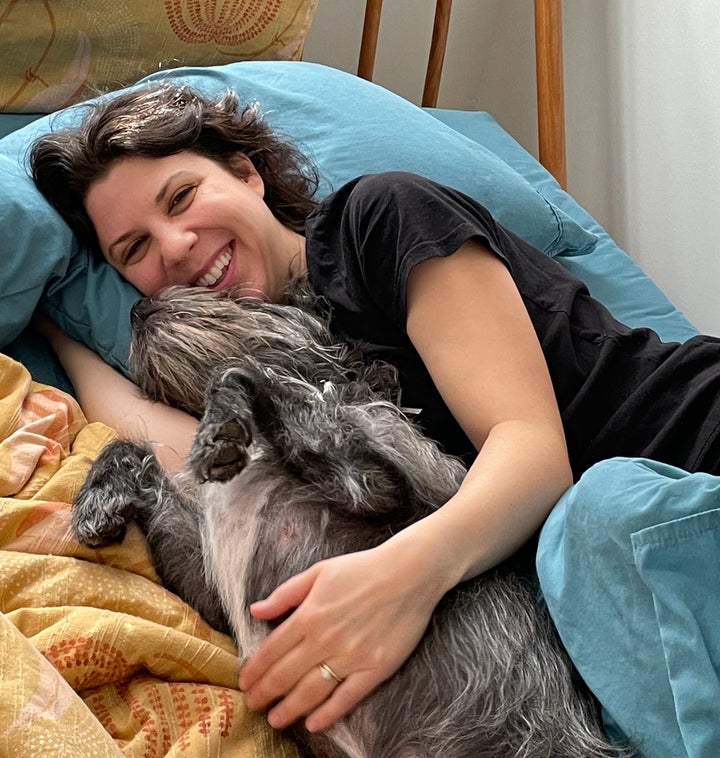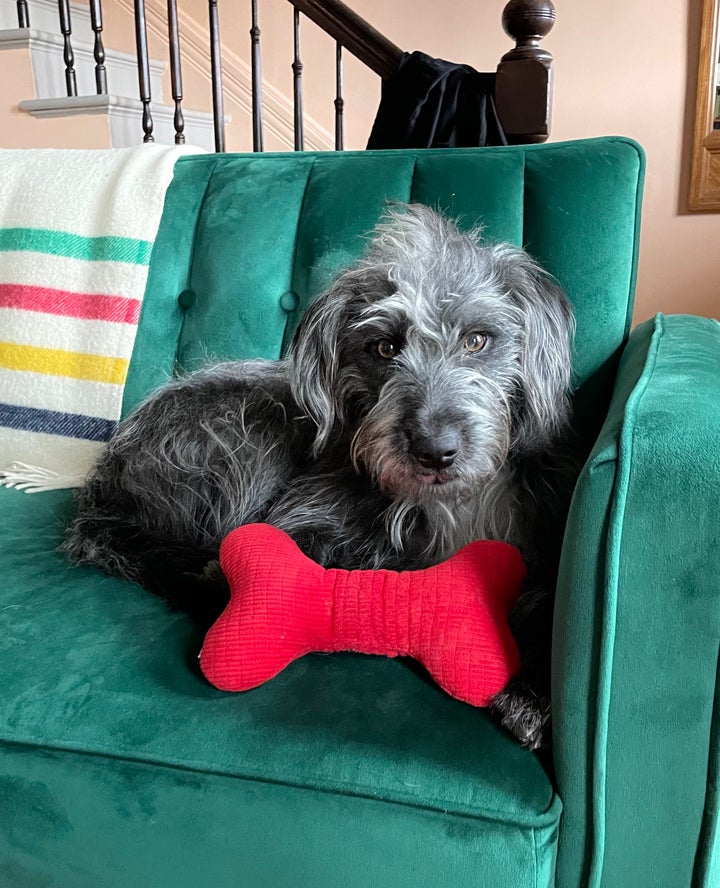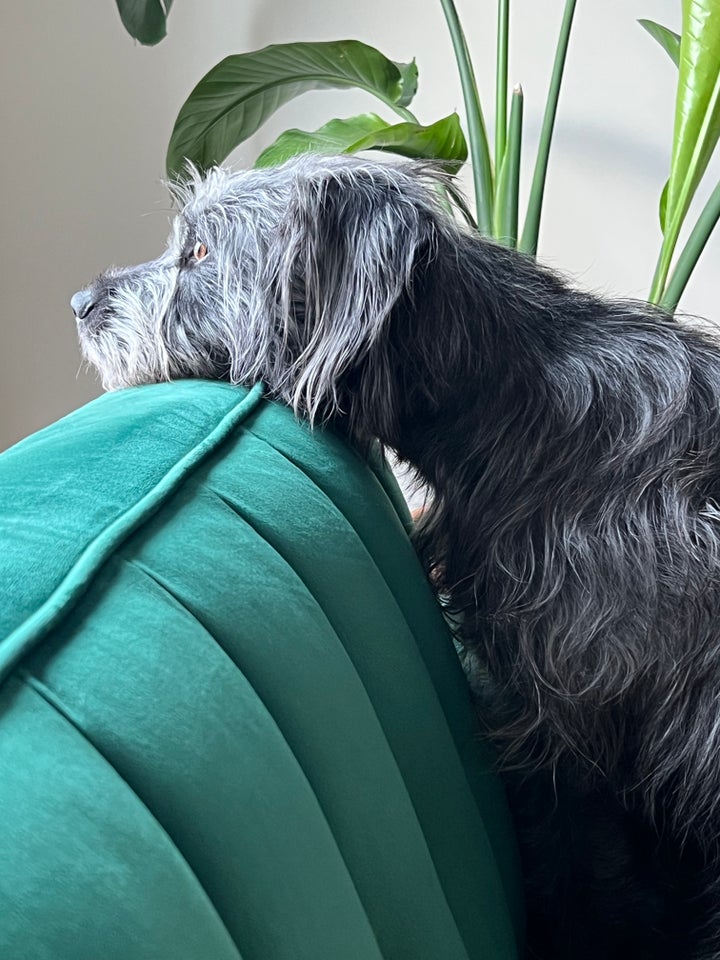
I’ll be the first to admit I know nothing about babies. One time, in conversation with a new mom friend, I asked if her 3-month-old had “opened his eyes yet.”
Then, a couple of years ago, my husband and I started checking off the boxes of traditional adulthood. We bought a car and a house, and then — instead of a baby, the biggest of check boxes — we felt ready to adopt a dog. It let us test the waters of parenting with a creature who couldn’t eventually tell us in plain English how much we suck at it.
I started scrolling through the adoption website Petfinder nearly every night, and at some point, there was Marty — his head cocked to the side, his tongue hanging out, and a big grin on his face, as if he had just told a joke. He was found on the side of a country road in Tennessee and given the ill-fitting moniker Markus by a Connecticut-based rescue team. His coarse, grey fur and bearded snout prompted the label of a schnauzer mix, but an at-home DNA test would later prove he’s more like a terrier mutt with some pit bull, cattle dog and Chihuahua thrown in.
It’s true what literally every person on Earth has ever said about having a dog: It’s a lot of responsibility. And that’s especially true for one with quirks like Marty’s. There were the cute quirks, like how he was always ready to play and rested his chin on pretty much anything available to him. And then there were the tough ones, like his habit of barking at the faintest sound of a passerby or lunging at male strangers he deemed a threat. (To him, they were all threats.)
Marty turned out to be the perfect distraction early last year when I found out I was both laid off and pregnant in the same week. I was just getting used to taking care of a dog, and now I’d have a baby to take care of? Instead of letting reality sink in, I irrationally focused many of my efforts (and anxieties) on him. I took him to dog trainers, bought new supplies and did hours of research online to see if I could capitalism my way to a perfect pooch amid the uncertainty bubbling up inside of me.
That bubble popped just six weeks later. I woke up to see that a thin sheet of freezing rain had frosted the yard overnight — a surprise, given the previous day’s sunshine. By the time that ice melted, I was no longer pregnant.
One in 4 pregnancies end in miscarriage, and that’s only counting those among people who know they’re pregnant. An estimated 23 million miscarriages happen around the world each year, or about 44 losses per minute. Having been through it — the blood, the cramps, the disappointment — I can confirm that none of those stats makes it hurt any less.
My biggest consolation was getting home to a dog that joyfully rushed to give me sweet, welcoming licks, completely unaware that I had just spent two hours in an emergency room having blood drawn, multiple ultrasounds and a heartbreaking conversation with a doctor.

Marty’s presence gave the whole experience a layer of relief and normalcy: Yes, a terrible thing happened, but I still got to go home and hang out with my dog. Our routines continued. We’d have breakfast and take a morning walk, and then he’d spend much of the day perched on “his” blue armchair, gazing out our bay window like a guard watching over his post.
The real test came months later, in the fall, as I entered the second trimester of another unexpected pregnancy.
This one was different. I still didn’t know anything about babies, but I was reading a ton and felt ready to ease into this new life. “I’m so glad it’s happening now and not then,” I told close friends I shared the news with. I felt nothing but optimism as I began my first ultrasound.
“How far along did you say you are?” asked the radiologist as she searched for a heartbeat.
“Eleven weeks,” I said, feeling my blood pressure spike as only my own (stressed) heartbeat surfaced. Oh, God, it was happening all over again.
Part of the pain of a miscarriage is the frustrating lack of answers. First, there’s the discomfort of having to wait for an official result from a doctor. I wouldn’t find out until many hours later that the radiologist was seeing a 6-week-old embryo on the screen, despite the 11 luxurious weeks it had been given to gestate.
The other frustration is never truly knowing why. Why me? Why now? Could my miscarriages have been prevented? I thought I had done everything “right” in these pregnancies, but I was still unsuccessful. I experienced the guilt and shame felt by many of those who miscarry.
Worse still, my body was not getting the message that this pregnancy was not viable. This is called a “silent miscarriage” or “missed abortion” in the medical world. Instead of miscarrying naturally, I had to go through with a medical abortion.
I was given a choice of the method and went with an at-home dose of misoprostol — a privilege of living in a state that respects women’s autonomy. Though less invasive, this still meant all I could do was lie on the couch watching sitcom reruns, spontaneously writhing through severe cramps while changing pad after pad after pad after pad.
Where was Marty? Right by my side. He was the ball of fur nestled in my duvet. The damp nose sniffing my tear-soaked face. The reason to get out of bed and into the world, even just briefly, while at my lowest of lows.
The whole ordeal lasted longer than it should have, and nearly a week later it became clear that I would also need dilation and curettage, the surgical procedure known as a D&C. This wasn’t a typical turn of events, but every reproductive journey is unique. It can be complicated and messy, and it requires advocating for yourself at every step. I’ve learned there is no “right” or “wrong,” just ups and downs.
I knew my rescue mutt wasn’t a telepathic healer, but he somehow understood that I was physically limited during those weeks. He didn’t put me through his usual antics of moving shoes to different rooms of the house, or the game “I’ll nip at your hands until you play with me.” He was as gentle and comforting as could be for an animal who didn’t know what was going on.
Now that it’s all over, it feels weird to say that I’m grateful — not for what happened, but for what I have. Instead of seeing Marty as a box to check off on the way to starting a family, I get to enjoy the family we already have with him now.
I try not to wring my hands over what the future will bring. Dogs live mainly in the present, and I’m happy to be here in ours.

Do you have a compelling personal story you’d like to see published on HuffPost? Find out what we’re looking for here and send us a pitch.